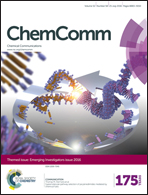Passive tumour targeting and extravasation of cylindrical polymer brushes in mouse xenografts†
Abstract
The shape-persistent nature and conformation of cylindrical polymer brushes (CPBs) present opportunities to explore the properties of anisotropic (i.e. non spherical) nanomaterials in biological settings. This study shows that CPBs with lengths of up to 1 μm are able to passively target tumours via the enhanced permeation and retention (EPR) effect. Moreover, large CPBs with higher aspect ratios (ARs) were able to penetrate tumours with similar efficiencies to much smaller systems with lower ARs.

- This article is part of the themed collection: 2016 Emerging Investigators


 Please wait while we load your content...
Please wait while we load your content...